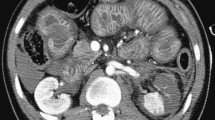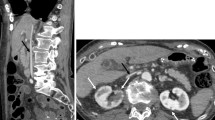Abstract
Shock thyroid is a part of the hypovolemic shock complex, which is a constellation of secondary computed tomographic (CT) findings that are observed in patients with hypovolemic shock. However, to the best of our knowledge, there has only been a single report on this condition, which described three cases associated with significant thoracoabdominal trauma. Here, we report four patients with profound hypotension who exhibited similar CT findings as those described in the initial report on shock thyroid, but with a more diverse clinical spectrum.





Similar content being viewed by others
References
Wang J, Liang T, Louis L, Nicolaou S, McLaughlin PD (2013) Hypovolemic shock complex in the trauma setting: a pictorial review. Can Assoc Radiol J 64(2):156–163
Brochert A, Rafoth JB (2006) Shock thyroid: a new manifestation of the hypovolemic shock complex in trauma patients. J Comput Assist Tomogr 30(2):310–312
Ames JT, Federle MP (2009) CT hypotension complex (shock bowel) is not always due to traumatic hypovolemic shock. AJR Am J Roentgenol 192(5):W230–W235
Sivit CJ, Taylor GA, Bulas DI, Kushner DC, Potter BM, Eichelberger MR (1992) Posttraumatic shock in children: CT findings associated with hemodynamic instability. Radiology 182(3):723–726
Lubner M, Demertzis J, Lee JY, Appleton CM, Bhalla S, Menias CO (2008) CT evaluation of shock viscera: a pictorial review. Emerg Radiol 15(1):1–11
Prasad KR, Kumar A, Gamanagatti S, Chandrashekhara SH (2011) CT in post-traumatic hypoperfusion complex--a pictorial review. Emerg Radiol 18(2):139–143
Ryan MF, Hamilton PA, Sarrazin J, Chu P, Benjaminov O, Lam K (2005) The halo sign and peripancreatic fluid: useful CT signs of hypovolaemic shock complex in adults. Clin Radiol 60(5):599–607
Gutierrez G, Reines HD, Wulf-Gutierrez ME (2004) Clinical review: hemorrhagic shock. Crit Care 8(5):373–381
Author information
Authors and Affiliations
Corresponding author
Ethics declarations
Conflict of interest
The authors declare that they have no conflict of interest.
Source of funding
There is no source of funding received for this work.
Rights and permissions
About this article
Cite this article
Han, D.H., Ha, E.J., Sun, J.S. et al. Remarkable CT features of shock thyroid in traumatic and non-traumatic patients. Emerg Radiol 24, 319–324 (2017). https://doi.org/10.1007/s10140-016-1475-1
Received:
Accepted:
Published:
Issue Date:
DOI: https://doi.org/10.1007/s10140-016-1475-1




